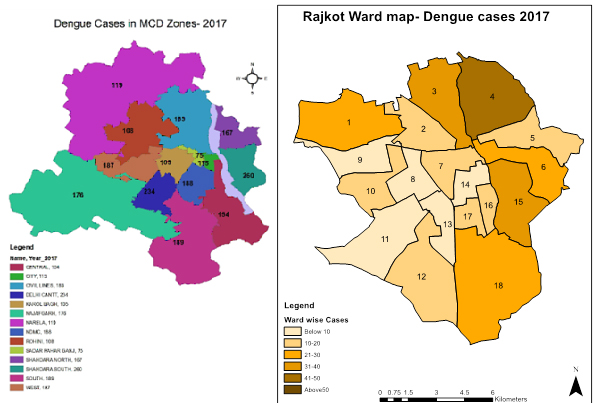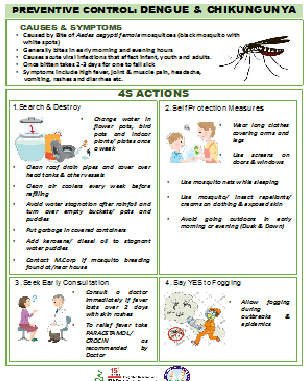Duration: September 2017- January 2021
Supported by: Department of Science and Technology (DST), Government of India
Spatial maps showing ward level Dengue incidences in Delhi and Rajkot were prepared using Geographic Information System (GIS) for showing the trends of Dengue incidences in the last decade as per data collected from the city Municipal Corporations. Dengue hotspots were identified for both the cities.
Primary surveys were carried out to collect information about incidences, possible local factors and their effects and impacts. In addition, we have initiated survey in collaboration with Rajkot Municipal Corporation on ward wise number of daily breeding sites detected, daily number of cases reported to further assess the linkages between climate variables and Dengue incidences.

Trend analysis of Dengue cases in Rajkot were carried out at ward level for incidences that occurred during 2011-2017 and their relationship with the slum locations were studied.
Climate data has been collected for the city of Rajkot and further week wise cases of vector borne diseases have been collected. Regression model is being run to assess the relationship between the climate variables and Mosquito borne cases.
Awareness material for strategy for Dengue prevention and management for Rajkot city was also drafted.
Extensive literature on early warning systems for dengue prevention was reviewed to develop indices needed for developing an early warning system for dengue management. Subsequently, a research paper titled “Early warning system for Dengue in India: An updated systematic literature review” was finalised.

Regression analysis was employed to develop a model for predicting the number of dengue cases in Rajkot using Maximum Annual Average Temperature (Tmax). This model shall be further validated and refined by including more climatic parameters such as Minimum Annual Average Temperature, Annual Average Rainfall and Annual Average Relative Humidity.
Hotspot mapping (ward-wise) of dengue cases registered in Rajkot from 2011 – 2017, and in Delhi from 2014-2017 was carried out. As compared to previous years, 2016-18 recorded higher dengue incidences in the Eastern Zone of Rajkot. Incidentally, the Eastern zone has a higher number of slums within the city as well. A similar study is being carried out for Delhi, the data for which has been procured from North Delhi Municipal Corporation, New Delhi Municipal Council, South Delhi Municipal Corporation, East Delhi Municipal Corporation and Delhi Cantonment.